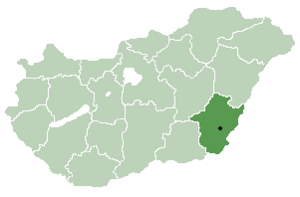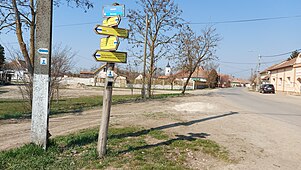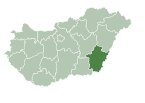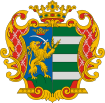| This article needs additional citations for verification. Please help improve this article by adding citations to reliable sources. Unsourced material may be challenged and removed. Find sources: "Zsadány" – news · newspapers · books · scholar · JSTOR (December 2023) (Learn how and when to remove this message) |
| Zsadány | |
|---|---|
 | |
 Coat of arms Coat of arms | |
| Country | |
| County | Békés |
| Area | |
| • Total | 65.86 km (25.43 sq mi) |
| Population | |
| • Total | 1,807 |
| • Density | 27.44/km (71.1/sq mi) |
| Time zone | UTC+1 (CET) |
| • Summer (DST) | UTC+2 (CEST) |
| Postal code | 5537 |
| Area code | 66 |

Zsadány is a village in Békés county, in the Southern Great Plain region of south-east Hungary.
Geography
It covers an area of 27.44 km and has a population of 1807 people (2001).
History
Inhabited since ancient times, the region was once home to the Getae and Sarmatians, ancient nomadic tribes. However, their tenure was marked by the migrations and settlements of successive peoples, including the formidable Hun and Avar tribes, who also established roots in this fertile land.
The turning point in Zsadány's history came with the arrival of the conquering tribes during the Hungarian conquest. In a significant event, these tribes laid claim to the land after capturing the Bihari Földvár, marking the beginning of a new chapter for the village. The year 1219 marks the first recorded mention of Zsadány in historical annals, found in the Regestrum Varadiense, recounting a grim incident involving a resident named Mikola accused of murder.

As the centuries unfolded, the village passed through the hands of various noble families, each leaving its own imprint on the landscape. In the 13th century, the Geregye clan, represented by Pál, a notable country judge, held sway over Zsadány. Subsequently, the Borsák family assumed the mantle of guardianship.
The 14th century brought a new chapter, with László of Arad, the alba regiai prépost of Tatamér, claiming ownership. During this period, Zsadány contributed to the ecclesiastical coffers, paying eight garas of papal tithe. The 15th century witnessed a succession of noble families – the Bacsók, Bajomiak, Thurzók, and Bocskai – each weaving their narratives into the intricate fabric of the village's history.
Zsadány's strategic location along vital military routes made it a target for marauding forces. The ravages of both Tatars and Turks in different periods left the village in ruins, a testament to the tumultuous times it weathered.
In the 17th century, Zsadány saw the dawn of organized religious life with the emergence of Reformed faith. The late 18th century brought further transformation with the construction of a church and tower that still stand proudly today, embodying the endurance of faith through the ages.
The 18th century marked a significant juncture as the village, along with 15 others, fell under the purview of Count Pál Esterházy. This consolidation gave rise to the Derecske estate, fostering a flourishing social and economic milieu that characterized Zsadány.
Before the redrawing of borders in the aftermath of World War I, Zsadány was an integral part of Bihar County, specifically belonging to the Cséffai district. Today, Zsadány's history resonates through its landscapes and structures, inviting contemporary observers to explore the layers of time that have shaped this resilient Hungarian village.
| Békés County | ||
|---|---|---|
| City with county rights |
|   |
| Towns | ||
| Large villages | ||
| Villages |
| |
| Other topics | ||
46°55′N 21°30′E / 46.917°N 21.500°E / 46.917; 21.500
References
- "Település bemutatása". zsadany.hu. Retrieved 2023-11-27.
- ^ Dr. Makai, Sándor (1999). Zsadány Község Története - History of the Zsadány (PDF) (in Hungarian). Zsadány Község Önkormányzata.